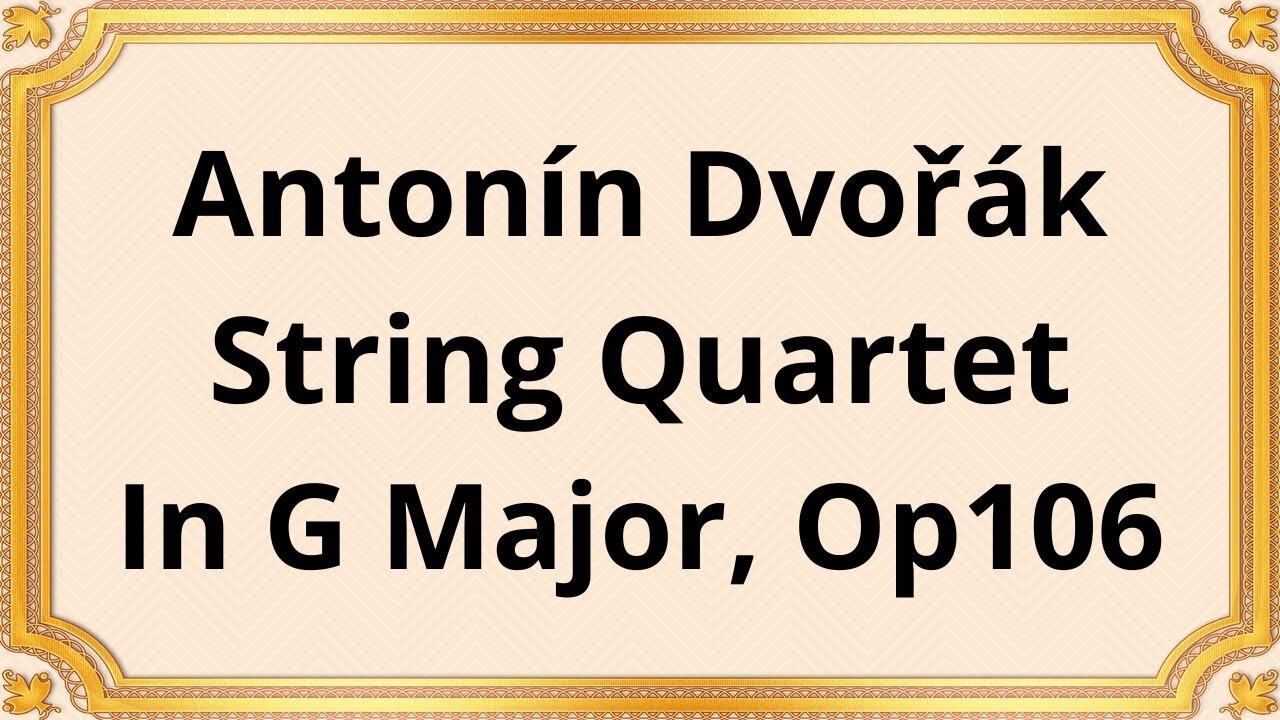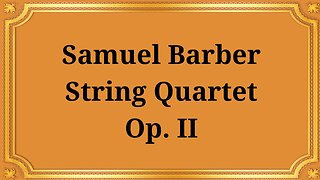Premium Only Content

Antonín Dvořák String Quartet In G Major, Op106
#AntoninDvorak #StringQuartet #GMajor #Op106 #ClassicalMusic #Composition #ChamberMusic #CzechComposer #RomanticEra #MusicAnalysis #MelodicThemes #HarmonicProgression #MusicalStructure #EmotionalDepth #MusicalInterpretation #Performance #HistoricalContext
The Kohon String Quartet
The Antonín Dvořák String Quartet In G Major, Op106 is a renowned composition in the world of classical music. Composed by the Czech composer Antonín Dvořák during the Romantic era, this string quartet stands as a testament to his exceptional talent and artistic vision.
Dvořák's String Quartet In G Major, Op106 follows the traditional four-movement structure commonly found in classical chamber music. The opening movement, marked Allegro moderato, introduces the primary melodic themes that will be developed and transformed throughout the piece. The second movement, marked Adagio ma non troppo, presents a contrasting mood, with its lyrical and introspective melodies. The third movement, marked Molto vivace, brings a lively and energetic character to the quartet, showcasing Dvořák's rhythmic prowess. Finally, the fourth movement, marked Finale: Andante sostenuto - Allegro con fuoco, provides a grand finale, combining elements of both lyricism and fiery intensity.
Dvořák's String Quartet In G Major, Op106 is characterized by its beautiful melodic themes and rich harmonic progression. The composer weaves together melodies that are both captivating and memorable, showcasing his gift for creating emotionally resonant music. The harmonies employed in this composition are lush and vibrant, adding depth and complexity to the piece. Dvořák's masterful use of chromaticism and modulations further enhances the musical experience, creating moments of tension and resolution that keep the listener engaged throughout.
One of the remarkable aspects of Dvořák's String Quartet In G Major, Op106 is its emotional depth. The composition traverses a wide range of emotions, from moments of introspection and melancholy to bursts of joyful exuberance. The performers have the task of conveying these emotions through their interpretation of the music. The quartet requires the musicians to exhibit both technical virtuosity and a deep understanding of the expressive intent behind the notes. Through their nuanced performances, they bring the music to life, evoking a profound emotional response from the audience.
Understanding the historical context of Dvořák's String Quartet In G Major, Op106 provides valuable insight into the composer's intentions and influences. Composed in 1895, this quartet reflects Dvořák's exploration of Czech folk music and his desire to incorporate nationalistic elements into his compositions. It also showcases his admiration for the Germanic tradition of string quartet writing, with influences from composers such as Ludwig van Beethoven and Johannes Brahms. By drawing from both his cultural heritage and the broader European musical tradition, Dvořák created a work that resonates with audiences across time and borders.
Conclusion:
Antonín Dvořák's String Quartet In G Major, Op106 is a remarkable composition that exemplifies the composer's genius and artistic prowess. Through its intricate musical structure, melodic themes, harmonic progression, and emotional depth, this string quartet continues to captivate audiences and musicians alike. Its historical significance adds another layer of appreciation, highlighting Dvořák's ability to blend nationalistic elements with the broader classical tradition. As listeners immerse themselves in the world of Dvořák's music, they discover a profound and enduring musical experience that transcends time and place.
You have the opportunity to support the channel:
https://destream.net/live/RadSiarAl/donate
https://www.buymeacoffee.com/6355radsiaral
-
 16:45
16:45
Classical music_Music Inspiration
2 days agoSamuel Barber String Quartet, Op. II
472 -
 15:24
15:24
Tactical Advisor
16 hours agoBest 2011 of 2025 | Bul Armory Ultralight Pro
829 -
 27:31
27:31
True Crime | Unsolved Cases | Mysterious Stories
1 day agoThe Hong Kong Schoolgirl Mystery – 5 Mysterious Unsolved Cases (Part 8)
171 -
 7:19
7:19
China Uncensored
22 hours agoChina is DONE in the South China Sea
2.35K11 -
 LIVE
LIVE
Joe Donuts Live
2 hours ago🟢 Loot Rats Unleashed: Arena Breakout Chaos! | Joe + Tony + Vlad
523 watching -
 30:37
30:37
Degenerate Plays
14 hours agoThis College Is Out Of Control - GTA Online : Part 9
40 -
 16:28
16:28
Mrgunsngear
2 days ago $0.49 earnedBeretta 92XI SAO Sabbia Review - A Few Surprises
3.46K5 -
 1:48
1:48
Memology 101
1 day agoThis aged like milk for Tish James...
6845 -
 LIVE
LIVE
Boxin
2 hours agoGrounded! part 5
153 watching -
 43:37
43:37
American Thought Leaders
16 hours agoAfter 9 Years of Investigation, Here’s What I Uncovered | John Solomon
3.68K7